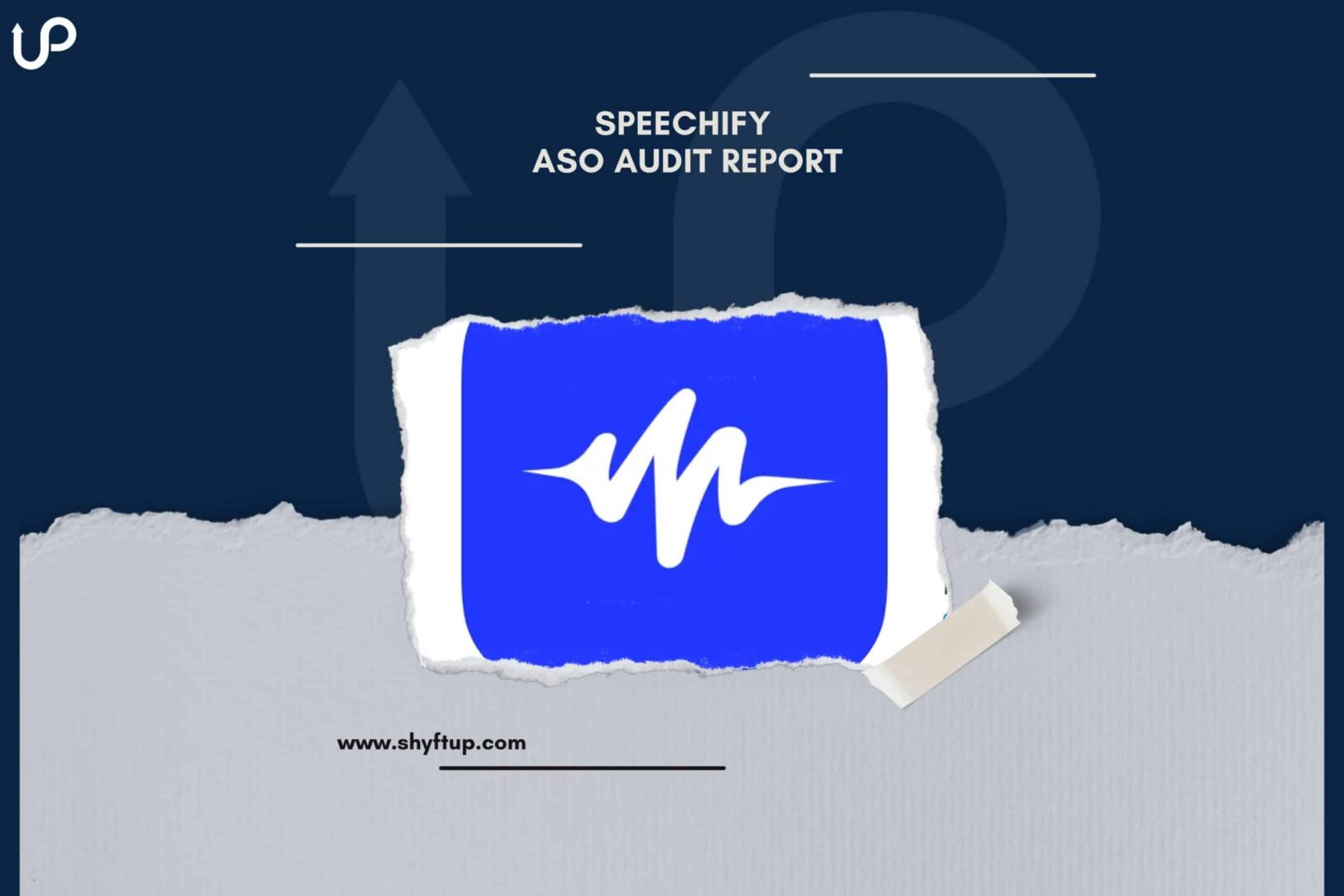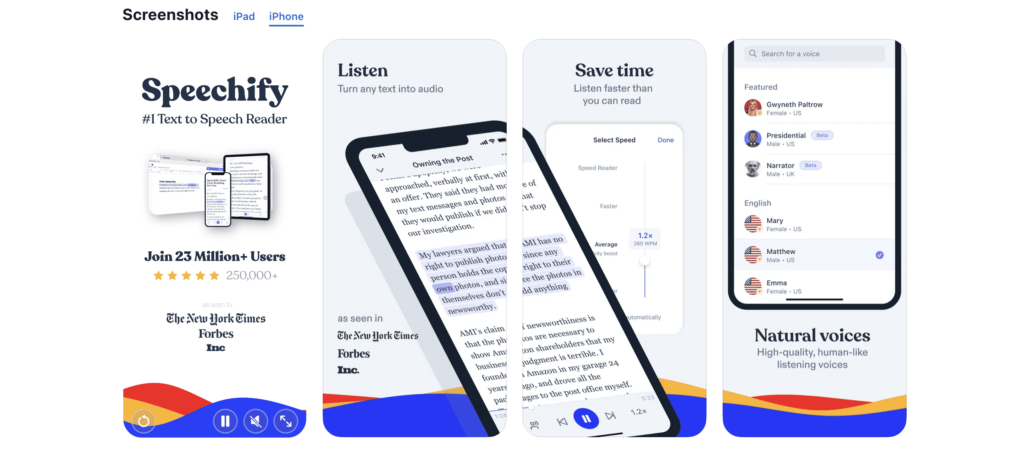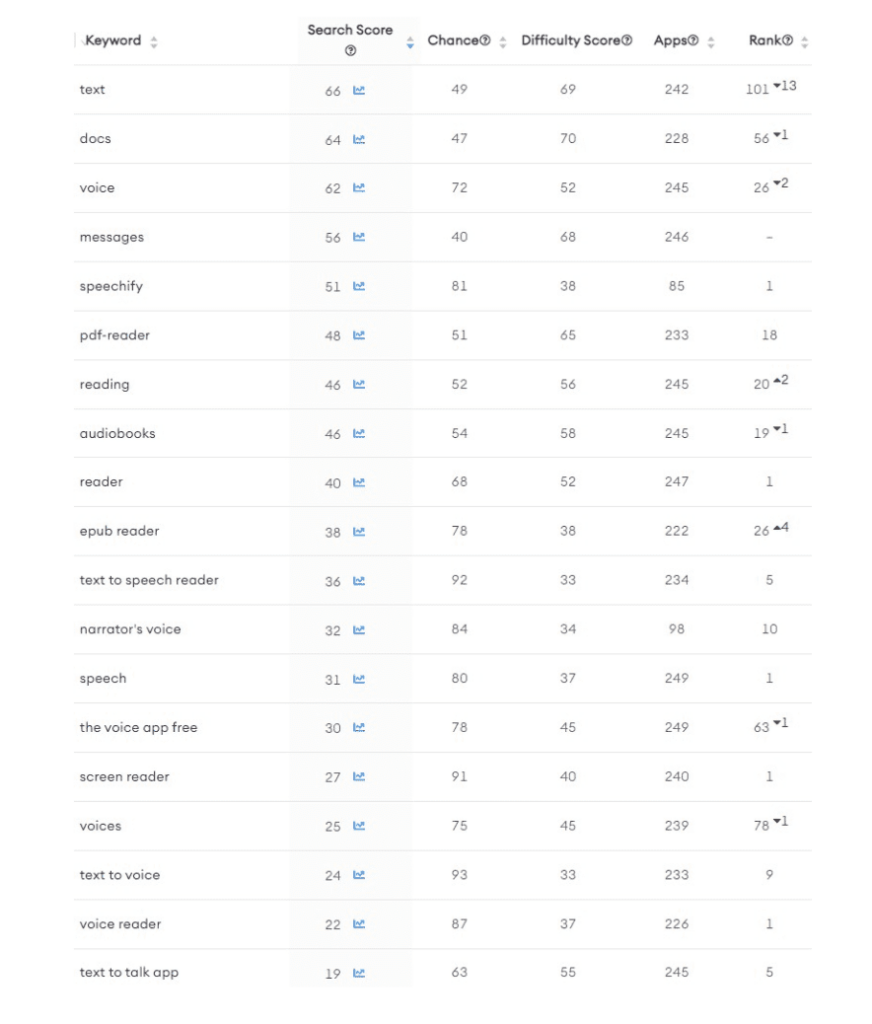
Speechify ASO Audit Report
IOS
Speechify is among the leading text to speech in app stores today. With over a million people who have downloaded the app, Speechify has enjoyed a relatively high ranking in the App Store. In fact, Speechify, by the time of this writing, is rated to be the #1 app in the News category.
While Speechify has already accomplished things that other text-to-speech apps haven’t achieved, there is still a way to maximize their app store visibility and therefore increase their chance of getting noticed.
After all, the biggest room is the room for improvement. No matter how great Speechify might already be, they can still do something to reach the number 1 spot and not be overtaken by competitors.
In this ASO audit, let’s take a look at how Speechify can improve its keyword ranking in the most efficient way possible.
Keyword research
We did a quick keyword research for Speechify. We have shared the details at the end of this post.
Looking at the research result, we can see that we are already ranking for some important keywords. Nevertheless, we have identified some great opportunities to take advantage of.
In this situation, ASO intelligence tools come in handy. These tools are effective in identifying popular keywords with the lowest competition. For example, in ShyftUp, we use Mobile Action to perform reliable keyword research.
Among the results we get is the term Search Score. Here’s a quick overview:
- The Search Score ranges from 5 to 100. The score represents the number of users who are searching for a specific keyword compared to other keyword options in the App Store and Google Play.
- To give you an example, one of the keywords with the highest ranking is the keyword, “Facebook.” It has a search score of 100.
- The lowest score is 5, which means no one is virtually searching for that keyword. Most keywords will never even see a score beyond 5.
Going back to the results that we got, here’s how Speechify’s ranking looks like:
- “Text” keyword has a search score of 66, which we rank at no. 101.
- “Docs” keyword has a search score of 64, which we rank at no. 56.
- “Reading” keyword has a search score of 46, which we rank at no. 20.
- “PDF-reader” keyword has a search score of 48, which we rank at no. 18.
- “Voices” keyword has a search score of 25, which we rank at no. 78.
- “Epub reader” keyword has a search score of 38, which we rank at no. 30.
- “Listening” keyword has a search score of 19, which we rank at no. 40.
We also did research on competitor keywords. We got the following results:
- “Narrator’s voice” keyword has a search score of 32, which we rank at no. 10.
- “Speak4Me” keyword has a search score of 17, which we rank at no. 20.
The results show us that there is a lot of work to do. To ensure that we climb up the rankings, we should use these keywords in our metadata.
Title
The title of Speechify in the App Store is this:
Speechify Text to Speech
Speechify already has a strong title. Take note that the App Store allows us to use up to 30 characters for the title. As of now, Speechify is using 24 characters.
Looking at the search scores of the keywords included in the title, the search score of “Text” is 66, and “Speech” is 31. As you can see, all the keywords have high search scores, and we can conclude that Speechify has a pretty strong title. However, there is a great opportunity for improvement.
To ensure we stay competitive, we must continuously test the title and its keywords. One way to improve the title is to go to the keyword pool. From there, we should continuously check how many keywords we are ranking for that are in the title. For instance, we could check the keyword “Text” in our keyword pool.
After starting to use the “Text” keyword, do we start ranking higher for these keywords? Do we start ranking for more keywords that include “Text”? If the keywords are not improving our ranking, then we should test other keywords and their variations.
In this case, we can try a new title like:
Speechify: Word to Voice App
As you can see, we have added the words “Word”, “Voice” & “App” and excluded the words “Text” & “Speech”. This is a great move in terms of keyword ranking for the following reasons:
- The term “Word” has a high search score of 72.
- The term “Voice” has a high search score of 62.
- The term “App” has a high search score of 54.
- By adding the term “Word” we can potentially rank for longer search terms such as “Word reader”. This has a good ranking score, which is 17.
- By adding the term “Voice” we can potentially rank for longer search terms such as “Text to Voice” and “Voice Reader”. All have good ranking scores, which are 24 & 22, respectively.
- By adding the term “App” we can potentially rank for longer search terms such as “The Voice App Free”, & “Text to Talk App”. All have good ranking scores, which are 30 & 19, respectively.
All these changes to the title can potentially improve keyword ranking. However, please note that there are other combinations and possibilities when it comes to using keywords.
That’s the reason you need to test these keywords constantly. You should check your keyword ranking every week and see if the changes in your title bring better results.
Subtitle
The subtitle of Speechify in the App Store is this:
Listen to the Web, Docs & PDFs
Like the title, Apple allows us to use up to 30 characters in the subtitle. As of now, Speechify uses 30 characters.
Looking at the search scores of the keywords included in the subtitle, the search score of “Listen” is 25, “Web” is 45, “Docs” is 64 and “PDFs” is 5. As you can see, all the keywords have high search scores except “PDFs” and we can conclude that Speechify has an average standard subtitle.
Even though, if we would like to test a new variation, the subtitle can be changed to:
Text, Doc, Pdf, Message Reader
As you can see, we have added the words “Text”, “Doc”, “Pdf”, “Message” and “Reader”, and excluded the words “Listen”, “Web”, “Docs” and “PDFs”. This is a great move in terms of keyword ranking for the following reasons:
- The term “Text” has a high search score of 66.
- The term “Doc” has a high search score of 47.
- The term “Pdf” has a high search score of 61.
- The term “Message” has a high search score of 58.
- The term “Reader” has a high search score of 40.
- By adding the term “Text” we can potentially rank for longer search terms such as “Text to speech reader”, & “Text to voice”. All have good ranking scores, which are 36 & 24, respectively.
- By adding the term “Message” we can potentially rank for longer search terms such as “Text Messages”, & “Voice Message”. All have good ranking scores, which are 28 & 23, respectively.
- By adding the term “Reader” we can potentially rank for longer search terms such as “Text to Speech Reader”, & “Screen Reader”. All have good ranking scores, which are 36 & 27, respectively.
To ensure we stay competitive, we must test the subtitle and its keywords continuously. One way to improve the subtitle is to go to the keyword pool. From there, we should continuously check how many keywords that are in the subtitle. For instance, we should check the keyword “Reader” in our keyword pool.
After starting to use the “Reader” keyword, do we start ranking higher for these keywords? Do we start ranking for more keywords that include “Reader”? If the keywords are not improving our ranking, then we should test other keywords and their variations.
Ratings

Looking at the ratings, we can see a lot of things to improve here. Take note that Speechify, at the time of this writing, has an average rating of 4.6 stars from more than 137.4K users.
Let’s compare that to their competitors:
- Text to Speech! – 4.7 stars from 25.2K users
- Speak4Me – Text to Speech– 4.6 stars from 7.3K users
We do need to improve app features and overall user experience to raise the ratings up and get more positive reviews.
Screenshots

Screenshots can either make or break your app. Use the wrong screenshots and you’ll surely chase away users. Use the right screenshots and you’ll attract more users.
As we take a look at Speechify’s screenshots, we can see that they have chosen great images. However, Speechify can use more value oriented headlines on the screenshots. It is super important to choose screenshots that show the value, features, and reasons why users should use your app.
In short, screenshots must convince users to choose your app.
The App Store allows us to use up to 10 screenshots. However, these screenshots don’t have equal exposure. As you may already know, potential users will initially see the first three screenshots. They need to open your page to see the rest of the screenshots.
With this in mind, you need to choose the best screenshots and place them on the first three screenshot slots.
To determine which screenshots give you the best result, A/B testing and Apple’s Product Page Optimization (PPO) are always the best way to go.
Here are a few more things to consider:
- Apple indexes the title, subtitle, and keyword list to determine app rankings in the App Store.
- The app title, which can be composed of up to 30 characters, is considered to be the most important ranking factor. Thus, you should add the most crucial keyword to your title. When you do that, you’ll most likely get a higher ranking for that keyword.
- Next to the app title is the subtitle in terms of importance for indexing. Thus, other more vital keywords should be added to your subtitle. Add as many relevant and high-ranking keywords as possible to ensure you increase your ranking. Moreover, if possible, maximize the 30 character-limit for the subtitle.
- Keyword list is considered to be the number 3 most important ranking factor in the App Store. You are allowed to use a maximum of 100 characters. You need to add all the keywords that you believe are relevant to your app. You can even include brand names and competitors’ keywords. You have more flexibility to include whatever you see fit based on your keyword research. After all, users won’t be able to see this list. Only you, as the admin, can see them via the App Store Connect. But it affects your visibility significantly.

This data is pulled from Mobile Action.
Disclaimer: In this ASO Audit, we haven’t used any private data, we have purely used public data.